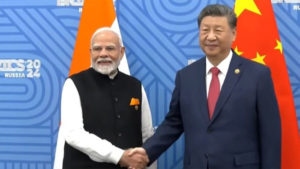
New Delhi: A day before Prime Minister Narendra Modi left for Russia to attend the BRICS Summit, a military agreement was announced between India and China on the LAC on October 21. The relations between the two countries have been sour since the violent clash between Indian and Chinese soldiers in Galwan in 2020. In such a situation, a 3D formula has been invented to solve the 2D problem.
India and China have agreed on an agreement to withdraw their troops from the Line of Actual Control and resume patrolling. This agreement is related to patrolling in Depsang and Demchok areas. To solve this 2D (Depsang and Demchok) problem, 3D i.e. Disengagement, De-escalation and D-Induction formula is being used.
What is the 2D problem?
India shares a 3,488 km long border with China. These borders are adjacent to Ladakh, Himachal Pradesh, Uttarakhand, Sikkim and Arunachal Pradesh and are divided into three sectors. These include the Western Sector i.e. Ladakh, Middle Sector i.e. Himachal Pradesh and Uttarakhand and Eastern Sector i.e. Sikkim and Arunachal Pradesh. But the reality is that there is no border line between India and China yet. There is no official demarcation on the ground or in any map. The LAC divides the two countries. After the violent clash between the armies of India and China in the Galwan Valley in 2020, several rounds of military and diplomatic talks took place.
After this, the armies of both the countries retreated from Galwan Valley, Pangong Tso and Gogra Hot Spring but the armies were still deployed at Depsang and Demchok. Amidst the increased tension after the Galwan incident, both the countries had increased the number of their troops on the border. But under this agreement between India and China, the armies of both the countries will now retreat from these areas. After this agreement, the soldiers of both the countries will retreat from the India-China border and in 2020, the Indian soldiers will be able to patrol the border with China as far as they used to.
What is the 3D formula?
To end this military deadlock between India and China, a 3D formula has been prepared, which is disengagement, de-escalation and de-induction. According to the report, these are the three words, due to which the ice on the relations of the two countries has started melting and both the countries have left the path of confrontation and have come to the negotiating table.
Disengagement
Disengagement means the retreat of soldiers on the border. If we define it in detail, then we can understand that the declared military policy is changed to withdraw the army of a country. But this happens with the mutual consent of both the countries. With the implementation of this agreement, Indian forces will be able to reach Patrol Point 10, 11, 11A, 12, 12A and Patrol Point 13 in Depsang. Let us tell you that the Rakinala area, Y Junction area, Bottle Neck area in Depsang were such areas where after May 2020, when the Indian Army used to go to its patrolling point, the Chinese army did not allow India to patrol there.
De-escalation
Under de-escalation, the soldiers, military equipment and weapons of both the countries will be brought to normal condition. This simply means that the armies of both the countries will give up aggression and come to normal condition. That is, the tension will reduce.
De-induction
Under de-induction, both the countries decide by consensus how many troops and cannon tanks they can keep in which areas. Which equipment and how much army will be removed from the disputed areas. Currently, more than 50 thousand troops of both the countries are deployed on the LAC in Ladakh, they should go to the same position where they were during peacetime. De-induction means bringing back the large number of soldiers and military equipment deployed there to their old position. Only then can it be said that the situation before April 2020 will be restored on the LAC.
The situation before 2002 on the LAC will be considered when these three D i.e. disengagement, de-escalation and de-induction are completed. As per the agreement made between India and China, disengagement in Depsang and Demchok means the soldiers of both the countries will retreat. Let us tell you that India has not changed its stand in bringing the status quo of 2020 in Depsang and Demchok. China respects power. In the last 4 and a half years, India did not allow China to move even a single step forward in the disputed areas. After this, China came to the table of agreement with India.
©2024 Agnibaan , All Rights Reserved